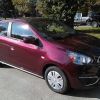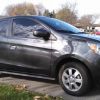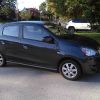Usually on the OEM style Hitachi battery, the fluid does not need to be topped up during its lfe. Fluid level will become a bit lower over time and acidity increases accordingly. It can be topped up to prolong battery life, because higher acidity damages the battery. If fluid drops more on somebody's car than usual, that has a cause. Perhaps the charging voltage is a bit on the high side.
The positive battery plates will develop an increasing layer of phosphate alloy over time. That reduces the charge and amperage a battery can produce. Some battery chargers have a "regenerate" mode, which will charge the battery at around 15.5 to 16.0Volts, causing the fluid to discharge water as a (hghly combustable!) gas mixture. It should be left in a ventilated place in regenerate mode for about 12 hours. That gas mixture is oxgen plus hydrogen being depleted water taken out of the fluid by electrolysis. During regenerate mode it forms bubbles on the positive plates that loosen and remove some of the phosphate build-up formed over time, and thus the battery regains some of its former performance.
After about five years use, a perfectly working battery will have developed enough phosphate on the positive plates to have lost some of its performance capability. This is where a "regenerate" charge will make an improvement to prolonging its life. After regenerating, fluid level should be checked, to ensure missing water has not increased its fluid acidty, which would shorten the batteries life. Do not overfill.
A regenerate-mode charge once every year or so pays off.
If your battery is not performing very well, it is worth a try topping it up wth distilled water, and to use a "regenerate mode" charge at around 16 volts for about 12 hours. It then should have regained a good part of its former capacity.


 2014 Mitsubishi Space Star (Mirage) 1.0L
2014 Mitsubishi Space Star (Mirage) 1.0L
 Reply With Quote
Reply With Quote
 Shelby
Shelby Zero
Zero Zero Sen
Zero Sen

